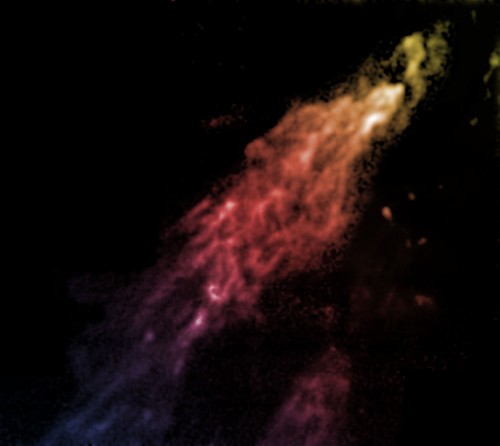
Image of Smith’s Cloud taken by the Green Bank Telescope. (Courtesy: Bill Saxton, NRAO/AUI/NSF)
By Margaret Harris at the AAAS meeting in San Jose
A giant cloud of hydrogen gas is barrelling towards the Milky Way faster than the speed of sound, and dark matter may hold it together long enough to produce a spectacular outburst of new stars in the night sky – but not for another 30 million years.
The cloud – which is known as Smith’s Cloud after Gail Bieger-Smith, who discovered it as an astronomy student in 1963 – is one of several starless blobs of hydrogen known to exist in the space between galaxies. According to Felix “Jay” Lockman, principal scientist at the US National Radio Astronomy Observatory’s Green Bank Telescope, such gas clouds are, in effect, “construction debris” left over from an earlier age of galaxy formation. “These are parts for remodelling your house that didn’t arrive by the time the contractor left,” Lockman told an audience at the 2015 AAAS meeting in San Jose, California.
What makes Smith’s Cloud special, he added, is that we know so much about it. We know its size (4 kiloparsecs long), its distance from our solar system (about 12 kiloparsecs) and its total space velocity (300 km s–1). And since 2008 we’ve also known that it is heading straight for us – or, rather, for a spot in the Milky Way about 10 kiloparsecs out from the centre.
What wasn’t known until recently, Lockman explained, was why the cloud hadn’t fallen apart. As it approaches the galactic disk of the Milky Way, tidal forces ought to be tearing it to shreds – yet as the image above shows, it is still very much there. In 2013 observations made at the Green Bank Telescope in West Virginia and the Very Large Array in New Mexico indicated that magnetic fields within Smith’s Cloud might be helping to maintain its integrity, and Lockman said that more detailed observations are expected later in 2015.
However, theoretical modelling carried out last year offers an even more intriguing possibility. In essence, the researchers (led by Matthew Nichols of the Ecole Polytechnique Fédérale de Lausanne in Switzerland) showed that a simulated high-velocity cloud composed solely of hydrogen would not be able to survive its passage towards the galactic disk – but a hydrogen cloud surrounded by a dark-matter envelope would. Hence, the starless blob of hydrogen we know as Smith’s Cloud could be merely the visible-matter component of a much more massive dark-matter “halo”, Lockman said.
Another mystery about Smith’s Cloud is where it comes from. Hydrogen is, of course, ubiquitous throughout the universe, and Smith’s Cloud contains around 2 million solar masses of it. But recent measurements by the Hubble Space Telescope found traces of other elements as well, including silicon and oxygen. Further analysis of these data may tell us more about the cloud’s origins, Lockman told Physics World.
Regardless of where it comes from or what keeps it together, Lockman expects that Smith’s Cloud will eventually contribute enough hydrogen gas to the Milky Way for several million new stars to form. And while galactic dust might prevent our distant descendants from seeing those new stars emerge in the night sky, an Earth-bound telescope operating at infrared or radio wavelengths would certainly detect them. “We’d be able to pick ’em up,” Lockman said confidently.
What a thrilling spectacle, this Smith Cloud of hydrogen and its well-composed compactness- probably due to the internal magnetic field and not the dark matter that, as shown recently, seems to be present everywhere.
This may be the first well-documented example of a Galactic Dweller, a sentient (although very slowly thinking) being comprised of the primordial matter of the Big Bang aftermath. The cohesiveness of the structure, combined with the non-standard elemental components, make this a possible near-certainty. For the uninitiated, Galactic Dwellers are VERY slow moving, slow thinking sentients which developed only a short time after photon opacity in the early universe ended. They sail across their galactic neighborhoods manipulating magnetic fields for gross directional movements.
I LOL’d.
The dark matter hypothesis sounds right as the cloud should be attended by a halo of dark matter.
M. Asghar. Recent observations (of the milky way) do not show dark matter is everywhere. Rather that there is a concentration of dark matter near the centre of the galaxy, along with a possible halo extending from the outer parts (possibly two different causes of dark matter). The orbital speeds in the mid ranges, however, show no evidence for dark matter.
Respectd sir ,
If u r kind enough cud u clear my doubt about the speed of light ?? I know its not based on this article . Kindly forgive me if its a stupid doubt . My name is Tony and im an engineering student . My doubt is how can light be faster than anything ?? If light is faster than any object in the universe then the particles making up the light i.e. photon’s vibration shud be faster than the apees of light ryt ???
Fred Hoyle, the British Astro-physicist who favored the steady state hypothesis for the “creation” of the universe, wrote a science fiction book called, if I remember correctly, The Black Cloud. It was about just such a sentient cloud, a Galactic Dweller, as it is called in the second comment above. Neat.